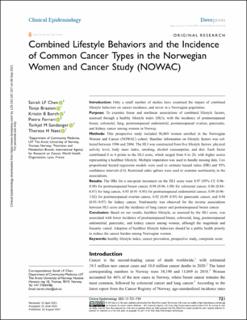| dc.description.abstract | Introduction: Only a small number of studies have examined the impact of combined lifestyle behaviors on cancer incidence, and never in a Norwegian population.
Purpose: To examine linear and nonlinear associations of combined lifestyle factors, assessed through a healthy lifestyle index (HLI), with the incidence of postmenopausal breast, colorectal, lung, postmenopausal endometrial, postmenopausal ovarian, pancreatic, and kidney cancer among women in Norway.
Methods: This prospective study included 96,869 women enrolled in the Norwegian Women and Cancer (NOWAC) cohort. Baseline information on lifestyle factors was collected between 1996 and 2004. The HLI was constructed from five lifestyle factors: physical activity level, body mass index, smoking, alcohol consumption, and diet. Each factor contributed 0 to 4 points to the HLI score, which ranged from 0 to 20, with higher scores representing a healthier lifestyle. Multiple imputation was used to handle missing data. Cox proportional hazard regression models were used to estimate hazard ratios (HR) and 95% confidence intervals (CI). Restricted cubic splines were used to examine nonlinearity in the associations.
Results: The HRs for a one-point increment on the HLI score were 0.97 (95% CI: 0.96– 0.98) for postmenopausal breast cancer, 0.98 (0.96– 1.00) for colorectal cancer, 0.86 (0.84– 0.87) for lung cancer, 0.93 (0.91– 0.95) for postmenopausal endometrial cancer, 0.99 (0.96– 1.02) for postmenopausal ovarian cancer, 0.92 (0.89– 0.95) for pancreatic cancer, and 0.94 (0.91– 0.97) for kidney cancer. Nonlinearity was observed for the inverse associations between HLI score and the incidence of lung cancer and postmenopausal breast cancer.
Conclusion: Based on our results, healthier lifestyle, as assessed by the HLI score, was associated with lower incidence of postmenopausal breast, colorectal, lung, postmenopausal endometrial, pancreatic, and kidney cancer among women, although the magnitude and linearity varied. Adoption of healthier lifestyle behaviors should be a public health priority to reduce the cancer burden among Norwegian women. | en_US |

